Get PeakVisor App
Sign In
Search by GPS coordinates
- Latitude
- ° ' ''
- Longitude
- ° ' ''
- Units of Length

Yes
Cancel
Share ×

Scan the QR code and open PeakVisor on your phone
❤ Wishlist ×
Choose
Delete
Home to dense forests, rugged terrain, and the world’s highest tides, Fundy National Park is a true wonder to behold. The park is located along the southern coastline of the province of New Brunswick in eastern Canada and it is a world-famous outdoor recreation destination. While it may be better known for its tides than its mountains, Fundy National Park is home to 8 named high points, the highest and most prominent of which is Rossiter Hill (382 m/1,253 ft).
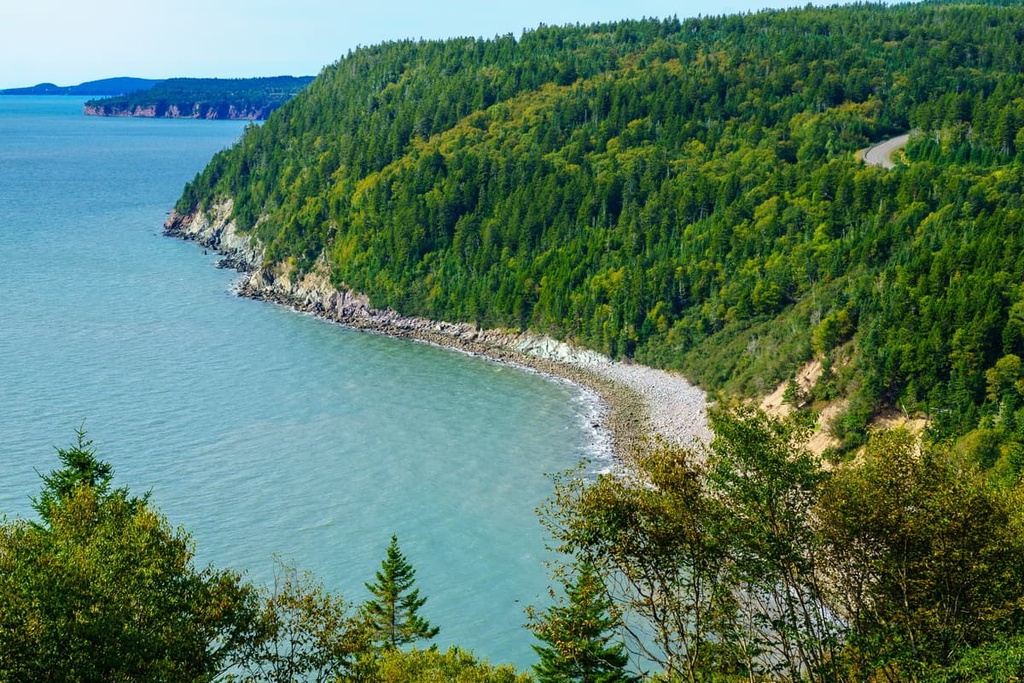
Fundy National Park is a federally protected area located in the Canadian province of New Brunswick. The park is situated along the southern coastline of New Brunswick in Albert and Saint John counties. It contains 207 sq. km (80 sq. mi) of land and is primarily located just outside the village of Alma in the parish of Alma.
The park itself encompasses a 20 km (12.4 mi) section of rugged coastline along the northern shores of the Bay of Fundy. It is located just to the southwest of the Isthmus of Chignecto, which connects New Brunswick with Nova Scotia.
Fundy National Park’s main feature is, of course, the Bay of Fundy. The Bay of Fundy is home to the world’s largest tidal variation. In fact, two times each day, the bay experiences high tides that are up to 12 m (39 ft) higher than its low tides. These incredible tidal variations are truly incredible to witness, which is why the park is so popular among visitors.
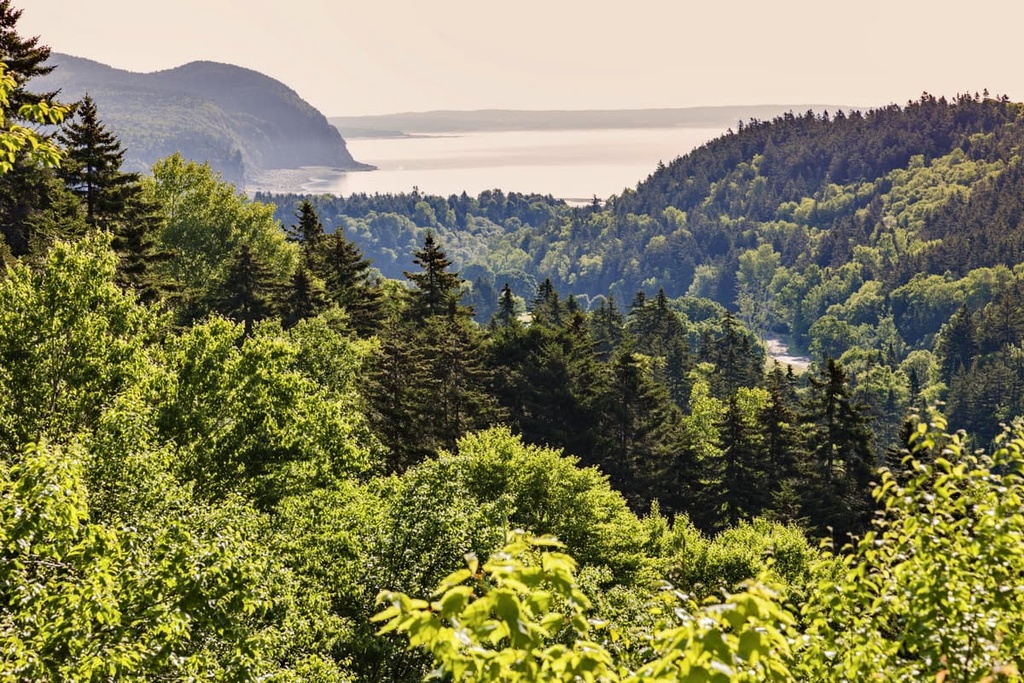
The park is also surrounded by a number of other protected areas and outdoor recreation destinations. This includes nearby preserves and natural areas such as:
Furthermore, just across the Bay of Fundy in Nova Scotia, there are quite a few other recreation areas that are worth checking out, including:
Geologically, the mountains in Fundy National Park are part of the Canadian Appalachians. The Canadian Appalachians are a subsection of the Appalachian Mountains that extends from the US border north through eastern Quebec and the Atlantic provinces to northern Newfoundland.
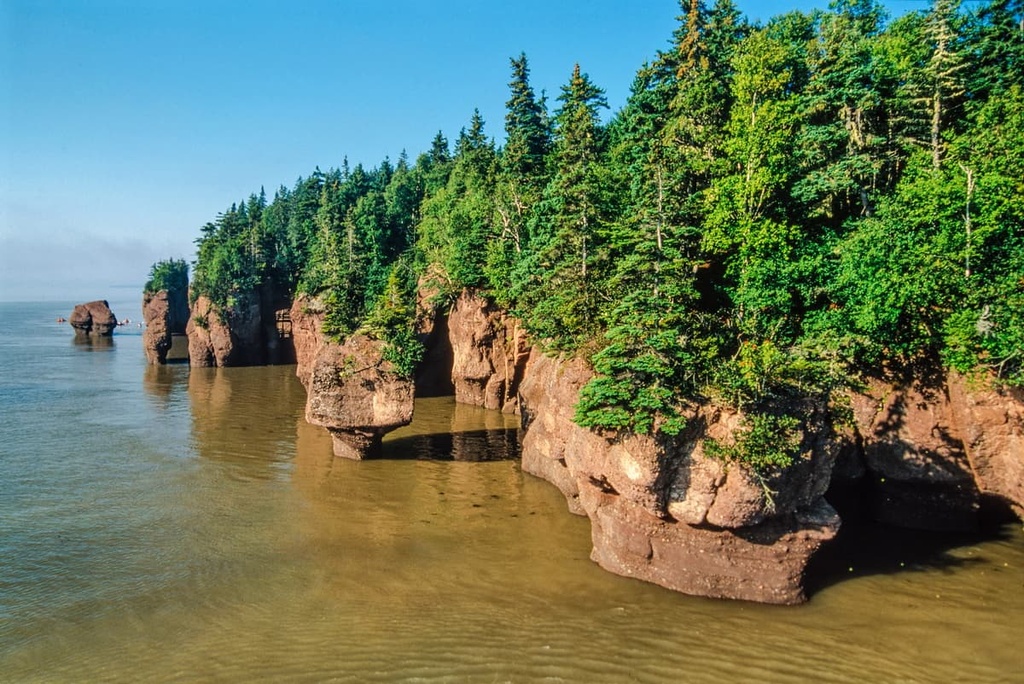
However, the most interesting part of Fundy National Park from a geologic perspective is arguably not its mountains but its namesake bay.
Geologists believe that, approximately 350 million years ago, the continental plates of North America and Africa were part of the supercontinent of Pangea and were located around the equator. Eventually, Pangea started to break up and North America started to separate from Africa as a result of a rift during the Jurassic.
By about 150 million years ago, the southernmost part of what is now Nova Scotia was still attached to what is now the state of Maine by a stretch of land. As this stretch of land filled in with water, it became a shallow lake that deposited large quantities of sediments. These sediments eventually became the potash, salt, and gypsum deposits that are mined in the region to this day.
After the shallow lake dried up, it remained water-free for many millions of years. However, the land that was left behind started to erode into a funnel-shaped depression thanks to the erosive power of the region's rivers and, later, the Pleistocene glaciation.
Once the glaciers started to melt at the end of the last glacial maximum, the area that we now call the Bay of Fundy started to fill in with seawater. Due to the funnel-shaped nature of the bay and its bathymetry (underwater topography), the bay experiences a huge tidal variation twice each day.

The Bay of Fundy’s tides, which can be 12 m (39 ft) higher than the low water mark (or, by some estimates up to 17 m/56 ft higher during storm surges), are the biggest in the world. The bay experiences such large tides because its bathymetry and shape provide the perfect location for a phenomenon called tidal resonance.
Tidal resonance happens whenever the amount of time that it takes for water to move from the mouth of a bay to the head of the bay and back again is nearly or exactly the same as the time difference between high and low tide. If this tidal resonance syncs up with the forces of the lunar tides, the moon’s gravity can amplify the effect of this tidal resonance and create truly massive high tides.
The fact that the Bay of Fundy also gets narrower and shallower as you reach the head of the bay also helps amplify these tidal differences. During high tide, water gets pushed further up on the shoreline in the Bay of Fundy than it would in a wide, deep bay. But the primary reason behind Fundy’s huge tides is tidal resonance.
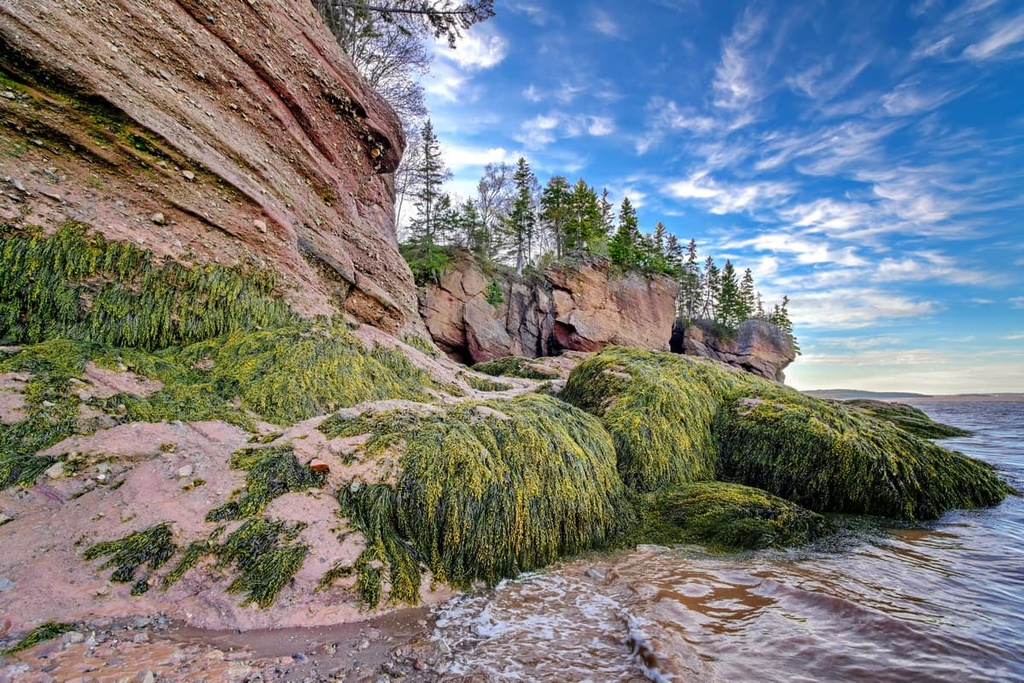
Viewing these incredible tides is one of the most popular pastimes in the park. Most days, the difference between high and low tide in the bay is about 6 hours and 13 minutes, but it’s important that you check the official tidal predictions for your chosen viewing location for more accurate tide timings.
It can be nice to return to the same location for both high and low tide so you can really see the impact that these tidal variations have on the surrounding landscapes and ecosystems.
Additionally, it’s worth pointing out that Fundy National Park is part of the Stonehammer UNESCO Global Geopark, which encompasses much of southern New Brunswick along the bay.
The area was designated as part of UNESCO’s Global Geopark Network in 2010 and it formally became a geopark in 2015. It contains an area of over 2,500 sq. km (965 m) that’s rich in geologic history.
Stonehammer contains more than 60 significant geological sites including a number of very well-preserved fossils. While the bay itself is much younger, some of the rock formations in the geopark are up to 500 million years old, and visiting them is definitely a worthwhile activity if you’re in the area.
Fundy National Park is best known for its huge tides, but there are plenty of ecological wonders in the park, too. In particular, the park is home to a diversity of ecosystems, including forests and bogs.
As far as tree species go, you’ll primarily see maples, yellow birches, white birches, balsam firs, and red spruces in the park’s forests. The forest floors in the park are mostly dominated by bunchberry, woodfern, and large carpets of moss.
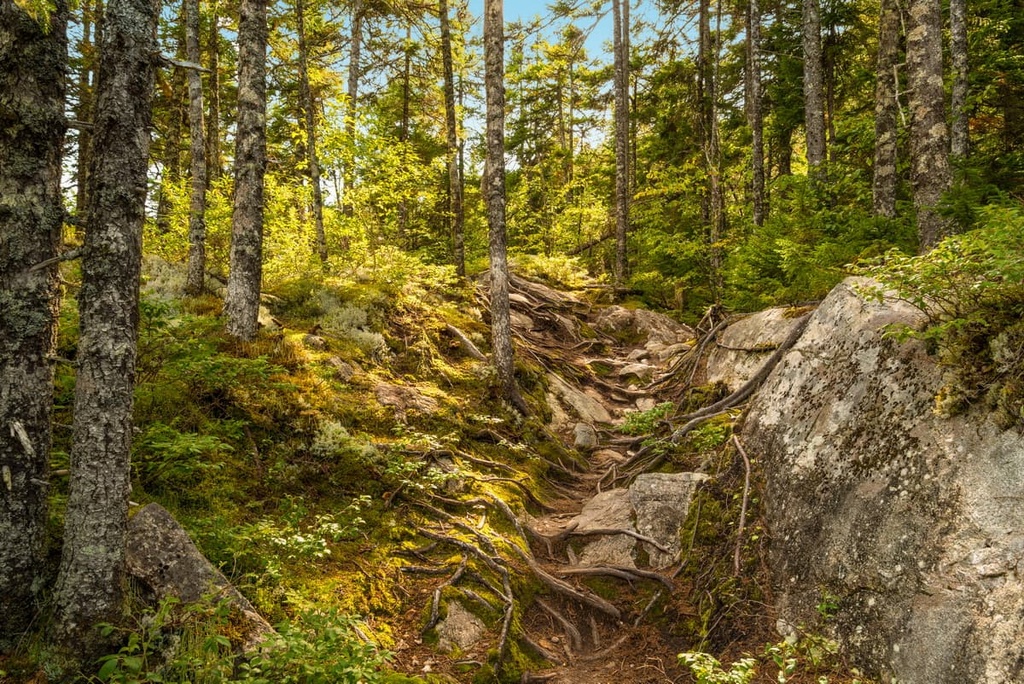
In the park’s bogs, you’ll find a mix of black spruce and larch trees interspersed with thick carpets of sphagnum moss. These bogs have highly acidic soils that stunt plant growth for many trees but are important habitats for a number of animals, including various species of frogs. The park’s bogs are also home to insectivorous plants like sundew, pitcher plant, and bladderwort.
That said, Fundy National Park has a decently large problem with invasive plant species. Some of the most common invasive species include woodland angelica, reed canary grass, and Japanese knotweed. There are programs in place to monitor and remove these invasive species as needed.
With regards to wildlife, Fundy National Park is home to a great assortment of animals. There are around 38 mammals that can be found in the park, including moose, coyotes, Canada lynx, white-tailed deer, and snowshoe hare.
More than 260 bird species have also been documented in the park. This includes over 95 nesting bird species as well as many others that stop in the park during their annual migrations. Some of the most commonly spotted bird species include ruffed grouse as well as various birds of prey, owls, and woodpeckers.
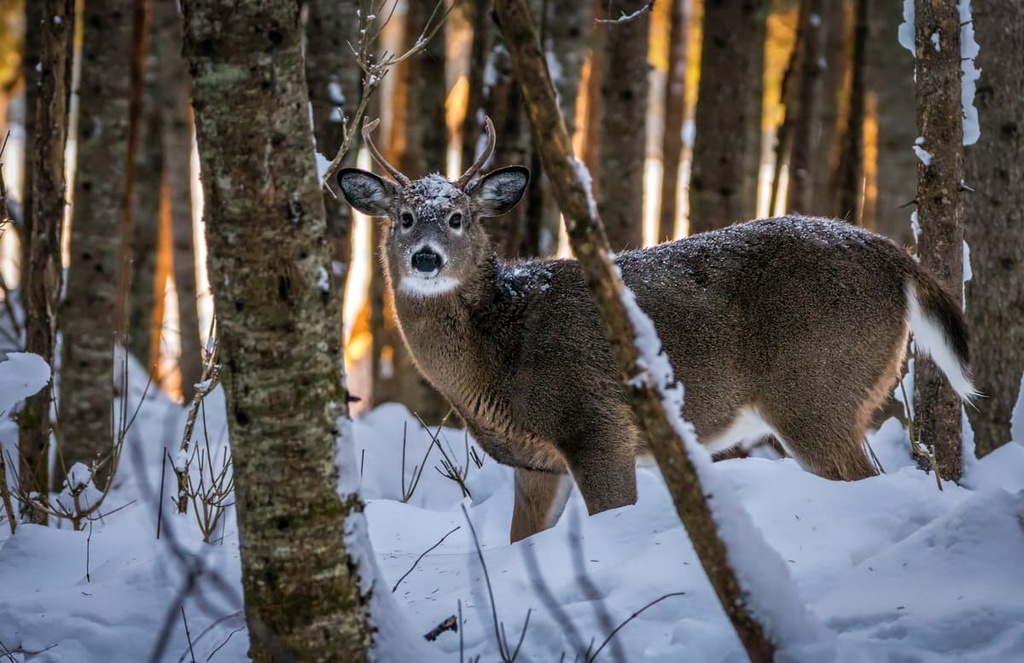
Fundy National Park offers the ideal habitat for many different kinds of reptiles and amphibians, too. There are at least 4 snake species that live in the park, including eastern garter snakes, though none are venomous.
Amphibians that live in Fundy include a number of frogs, toads, and salamanders. The park’s salamanders are of particular note as the region is home to three rare species: four-toed salamanders, northern dusky salamanders, and blue-spotted salamanders.
Finally, the waters of Fundy National Park are home to many fish species, the most notable of which is the Atlantic salmon. Atlantic salmon have lived in the inner Bay of Fundy for thousands of years but they were almost completely extirpated from the region due to pollution and human development. There are protection and recovery programs in place to help the species re-establish itself in the bay.
Humans have lived in the area that is now Fundy National Park since time immemorial. The land that is now part of the park is the traditional territory of the Wolastoqiyik, Mi’kmaq, and Peskotomuhkati First Nations.
First Nations, particularly the Mi’kmaq First Nations, have lived around the bay and fished in it for countless generations. The bay plays an important role in many of the creation stories and oral traditions of the First Nations who have lived in the region for thousands of years.
It’s unclear when the first person of European descent arrived in the region. Records suggest that João Álvares Fagundes of Portugal may have traveled to the bay in the 1520s, though this is a matter of some debate.
We do know, however, that the French established some settlements in the greater region that is now New Brunswick and Maine during the seventeenth century. For example, Saint Croix Island, which is located along the border of Canada and the US, was the site of a failed colony by Pierre Duga de Mons in 1604. The French also established a colony at Port Royal in 1605.
Samuel de Champlain traveled extensively throughout the Bay of Fundy during this time and he was involved with these early colonization attempts. He left the area not long afterward and traveled southward, though he eventually returned to what is now Canada and founded a colony at what is now Quebec City in 1608.
Although Port Royal, which is now known as Annapolis Royal, is located on the Nova Scotia side of the Bay of Fundy, it is the oldest European settlement in the region (it actually predates the British settlement at Jamestown, Virginia by two years).
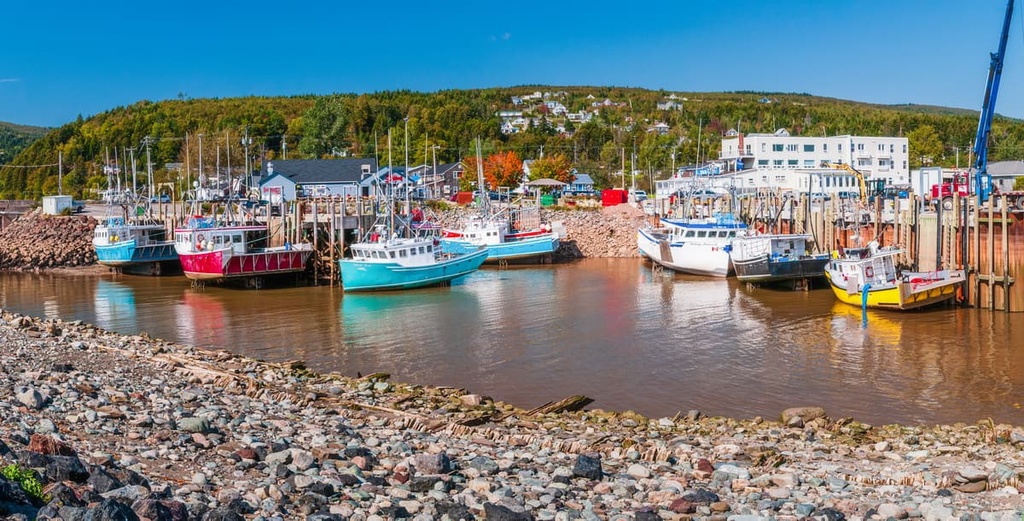
In the centuries that followed, the region changed hands a number of times. Early European settlers in the land around the bay were primarily French and, later, their descendants, the Acadians. The Acadians were later expelled by the British after they claimed control of the territory. Many of them were either sent back to Europe or they immigrated to what is now Louisiana in the US and eventually became known as the Cajuns.
During the nineteenth century, the Bay of Fundy area began to be known for its fishing and shipbuilding industries. The port of Saint John was particularly well-known as it built the clipper Marco Polo, which was one of the largest wooden ships ever built in Canada at the time.
The land around the bay still isn’t heavily populated outside of major cities and towns and there are some stretches of coastline that are undeveloped. Fundy National Park was established in 1948 in the hopes of both protecting the area’s natural beauty and stimulating the local economy.
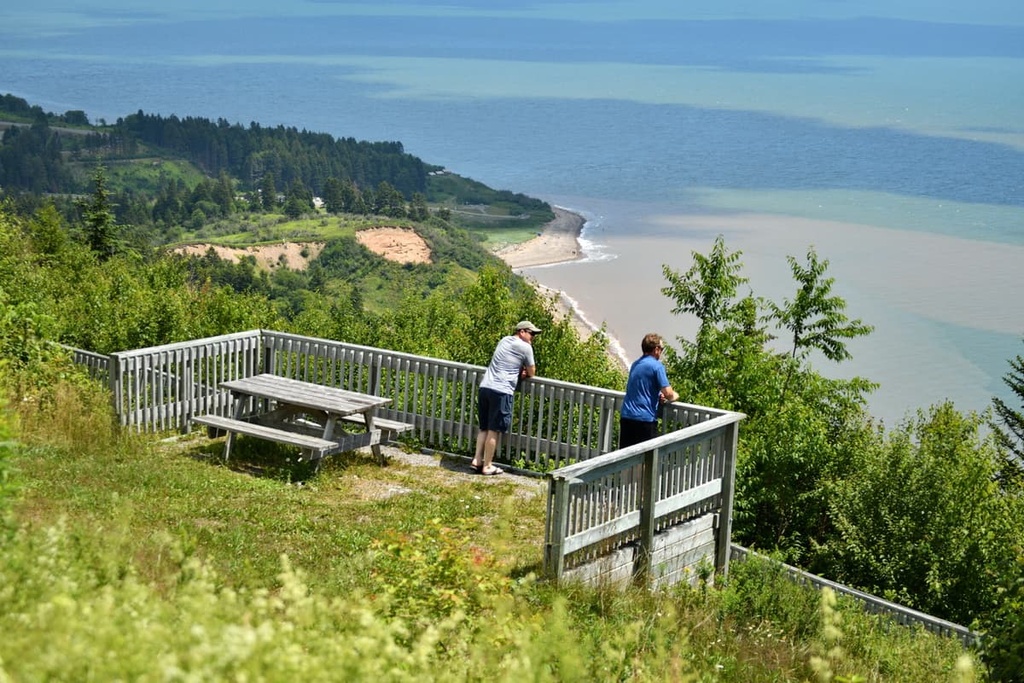
Any trip to Fundy National Park is sure to be a journey to remember. Here are some key things you ought to know before you set off on your adventure.
As is the case with most of the national parks in Canada, you do need to pay an entrance fee to visit Fundy National Park.
Admission is generally free for young people under the age of 17, but most other adults are charged a fee to travel to the park. You can get either a daily or a seasonal pass to the park depending on your travel plans. If you plan to visit multiple Canadian national parks, an annual Parks Canada Discovery Pass is usually worth considering.
Fundy National Park is very accessible by road from both of New Brunswick’s largest cities.
From Saint John, you can travel for about an hour and a half on New Brunswick Route 1 to get to the village of Alma and the park’s headquarters. If you’re traveling from Moncton, you can get to Alma in just over an hour on New Brunswick Route 114.
You can even get to Alma in around 4 hours from Halifax, Nova Scotia. Or, if you’re coming from the US, you can get to the park in around 4.5 hours from the city of Bangor, Maine. Just don’t forget your passport!
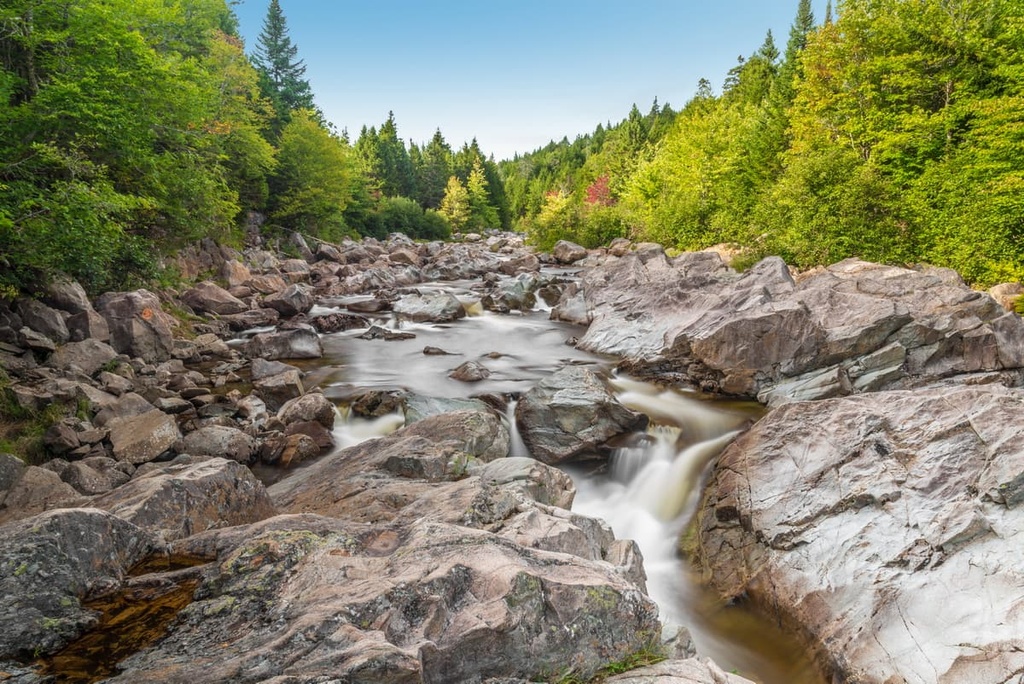
The main visitor center for Fundy National Park is located in the village of Alma near the Headquarters Campground. This headquarters is located in a recognized heritage center, which is a beautiful building that’s worth a visit.
The park also has another visitor center at Wolf Lake, which is situated at the northwestern entrance to Fundy National Park. Both visitor centers are normally open during regular business hours, though Wolfe Lake is closed in the winter.
You can get opening hours information for these two visitor centers, as well as the park’s two entrance kiosks, on the Parks Canada website.
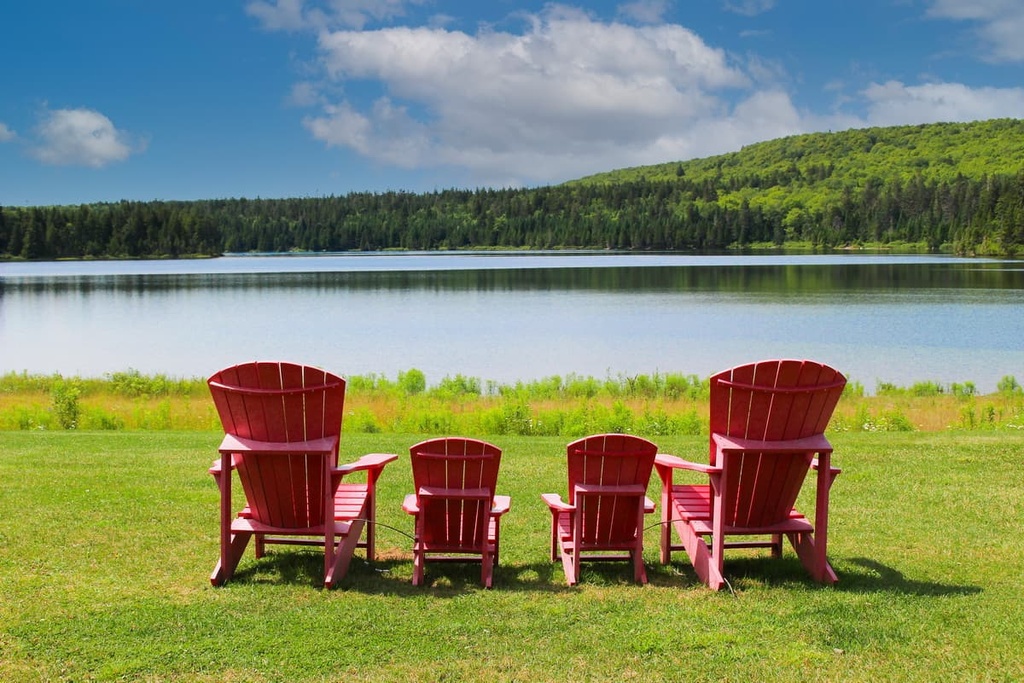
Fundy National Park is home to over 100 km (60 mi) of trails for hikers to enjoy. These trails range from short half-day outings to multi-day adventures and they travel across beaches, into the hills, and to gorgeous waterfalls.
With that in mind, here are some of the best hikes in Fundy National Park to check out during your next visit to the area.
The Fundy Footpath is one of the Fundy Bay region’s premier long-distance hiking trails. This 41 km (25 mi) trail begins at the large suspension bridge at the Big Salmon River and then hugs the coastline of the bay as it crosses into Fundy National Park.
Once the Fundy Footpath enters the national park, it follows the route of a number of other trails including the Goose River Trail, the 33 km (21 mi) long Fundy Trail, and then part of the 57.8 km (35.9 mi) Dobson Trail. The route itself is now fairly well maintained though it is strenuous and it takes you deep into the backcountry.
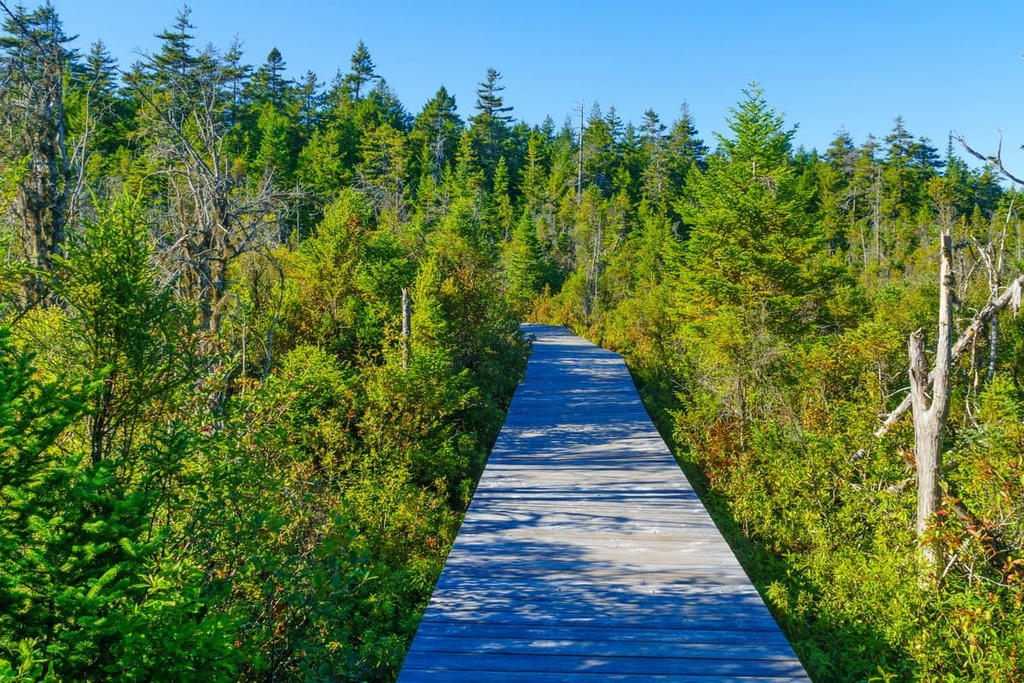
Along the Fundy Footpath, there are many backcountry campsites for thru-hikers to enjoy. But if you’re planning on hiking the trail, it’s worth getting the official Fundy Footpath Guidebook, which provides more information about the specifics of each leg of the route.
The Caribou Plain Trail is a short hike that takes you into some of Fundy National Park’s most scenic woodlands and bogs. This trail can also be snowshoed during the winter months and it makes for a great place to go stargazing at night.
You have two options when hiking the Caribou Plain Trail: a boardwalk loop that’s 0.5 km (0.3 mi) long and a longer 2.1 km (1.3 mi) loop. The boardwalk loop is accessible for people who use wheelchairs, and both routes make for a great day of family-friendly fun in the park.
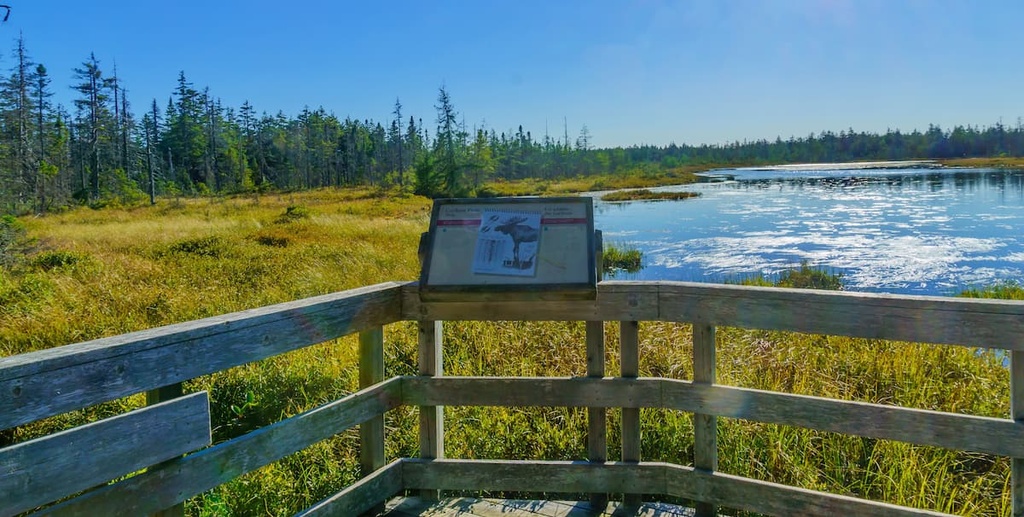
One of the best backpacking trails in the park, the Goose River Trail is 11.3 km (7 mi) long and it takes you into some of the park’s oldest forests. This trail can also connect you to the Fundy Footpath, so it’s an excellent option for people looking for both long and short adventures.
The Goose River Trail is particularly popular among backcountry campers. There are a number of campsites along the trail and along the Goose River Beach that are among the most spectacular in the region. Just remember that you need to reserve your backcountry campsite well ahead of time if you want to camp along this trail.
If you’re looking to cool off during a hot summer’s day, a trip to the Laverty Falls Trail just might be what you need. This 2.5 km (1.6 mi) long trail takes you into a stunning forest and to its namesake Laverty Falls, which tumble 12 m (39 ft) down a sheer rock face into a pool below.
At the falls, you can sit back and marvel at the view. Or, you can go for a swim in the deep pool that the falls have carved out over the millennia. Just keep in mind that there is no lifeguard on duty, so all swimming is at your own risk.
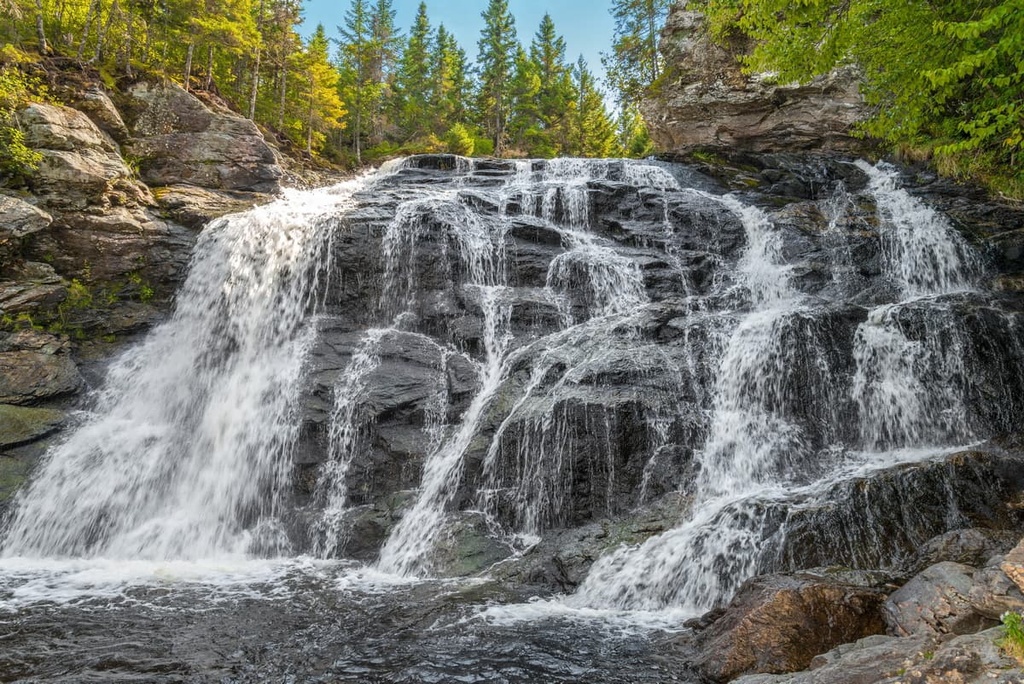
After you spend some time enjoying the falls, you can head back to the trailhead the way you came. Or, if you want a longer hike, you can follow the Moosehorn Trail, which is 4.8 km (3 mi) long and will loop you back to the trailhead.
For the true Fundy National Park experience, you can set off on the Fundy Circuit, a 48 km (30 mi) long network of hiking trails that takes you to some of the park’s most magnificent destinations.
This circuit links up seven of the park’s trails, including:
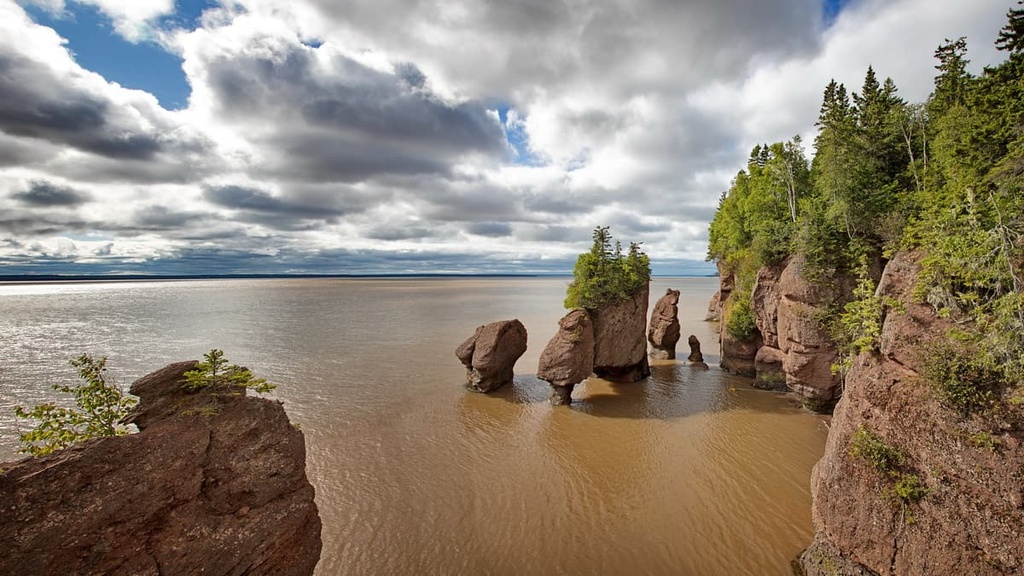
Parks Canada suggests hiking the circuit so that you start on the Coastal Trail and finish on the Upper Salmon River Trail. However, keep in mind that there are a number of river crossings on this route that can be dangerous in high water. You’ll also need to make reservations for campsites on this circuit as it takes most people three to five days to complete.
If you’re looking to spend the night in Fundy National Park, you have plenty of options to choose from. Here are some of the many accommodation options that you can check out as you plan your next visit to the region.
There are five frontcountry campgrounds in Fundy National Park:
Keep in mind that reservations are highly recommended if you want to camp at one of the park’s campgrounds. You can make your reservations online at the Parks Canada website. In general, Parks Canada lets you make reservations starting in January and February for campground visits between April of that year and March of the following year.
Most campsites in Canada’s national parks fill up quickly, so be sure to make your reservations well in advance.
In addition to its five frontcountry campgrounds, Fundy National Park has eight backcountry campsites for the more intrepid travelers among us.
These backcountry campsites are usually open from late spring to late fall each year and they can each accommodate 4 campers. Each site has its own tent pad, picnic table, and pit toilet, though you may need to bring your own water.
Since there are so few backcountry campsites in the park, you’ll want to make your reservations as early as possible. You can reserve backcountry campsites in Fundy National Park online at the Parks Canada website.
If you’re looking to spend the night in Fundy National Park with a roof over your head, you also have plenty of great accommodation options to choose from. These include:
Advanced reservations are essential if you want to stay at any of these developed accommodations. All reservations can be made online at the Parks Canada website.
Looking for a place to stay near Fundy National Park? Here are some of the best nearby cities and towns to check out during your travels.
The village of Alma is situated just outside Fundy National Park and is home to the park’s headquarters. Although fewer than 300 people live in Alma, its proximity to the national park and its natural beauty have made it a particularly popular tourist destination.
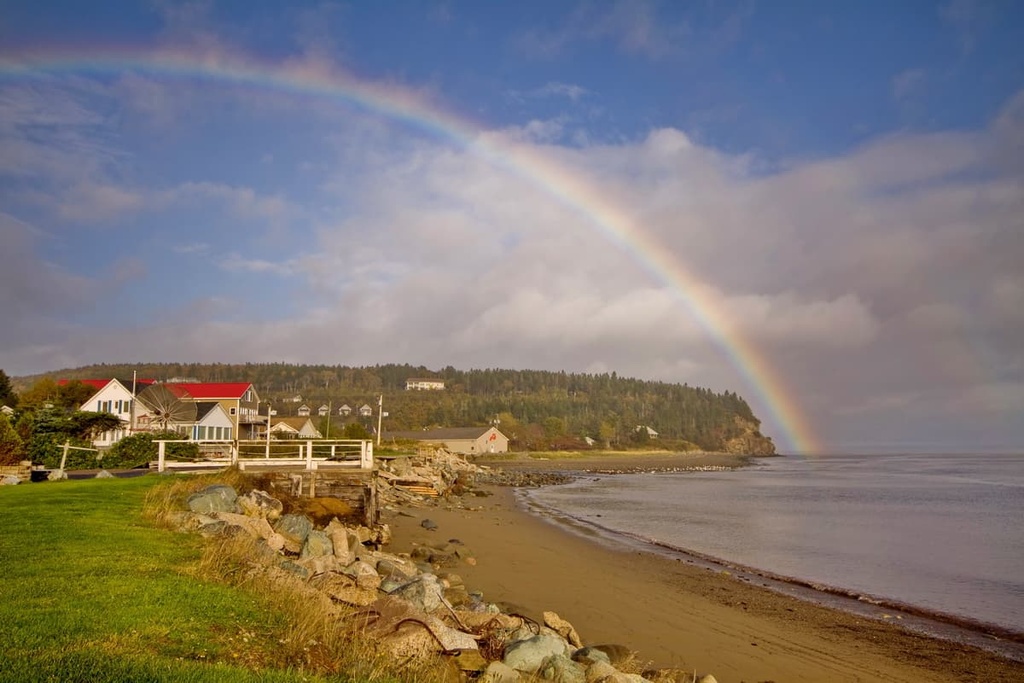
In Alma, you’ll find plenty of great hotels, inns, and B&Bs that cater to park visitors. While in town, you can also stop by one of the town’s many restaurants and cafés, or you can enjoy a quick drink at the Holy Whale Brewery.
Alma is also located just across the bridge from the park’s Headquarters Campground, which features a great selection of trails, so it’s a great place to base yourself for a trip to Fundy National Park.
St. Martins is another small village with fewer than 300 residents that’s located near Fundy National Park. The village is situated just to the southwest of the park along the coast and it has a long history of being one of the most productive shipbuilding towns in the region.
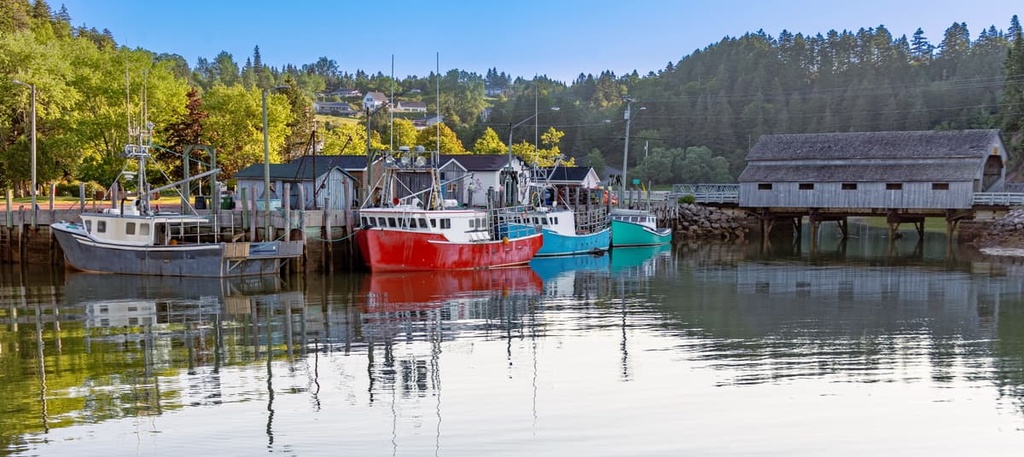
Nowadays, St. Martins is known for its historic twin covered bridges and for being home to the Quaco Head Lighthouse. In St. Martins, you can also find the trailhead for the Fundy Footpath. For a good rainy day activity in town, be sure to check out the Quaco Museum and Library, too.
Located to the southwest of Fundy National Park, Saint John is a city and major commercial center in southern New Brunswick. Saint John is actually one of the largest ports in Canada based on the amount of cargo that it handles each year. It was also the most populous city in New Brunswick until 2016 when Moncton became the largest city in the province.
Saint John is a worthy tourist destination in its own right. It has a long and storied history as part of the traditional territory of the Wolastoqiyik and Mi'kmaq First Nations, and it was the landing site of Samuel de Champlain when he arrived in the area in 1604.
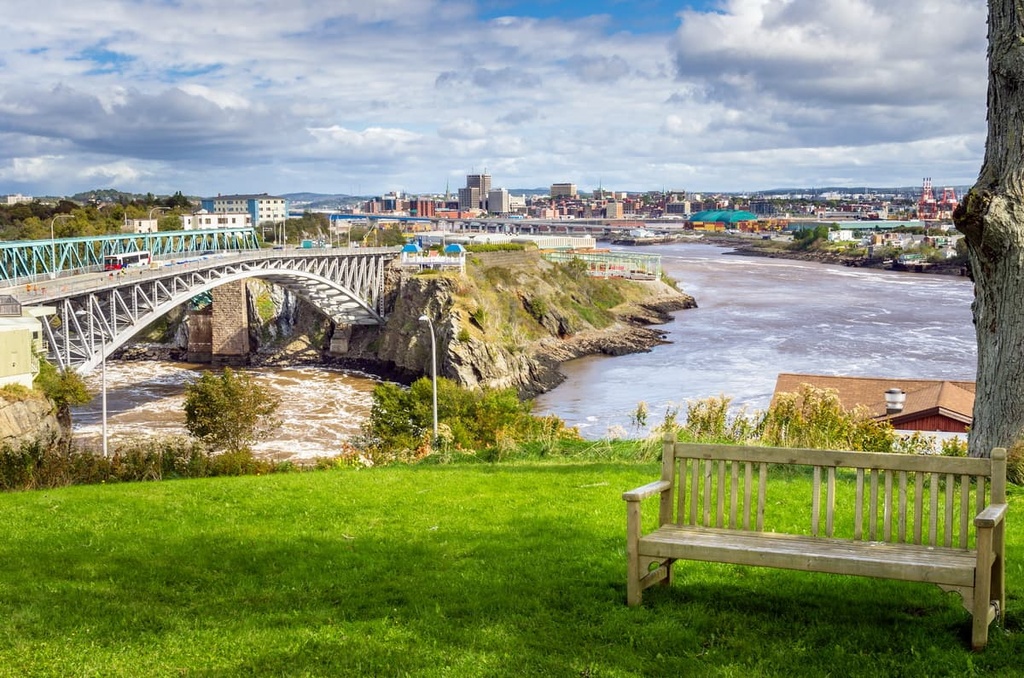
These days, Saint John is bustling with energy and activity. There are many theaters and museums in the city to visit as well as plenty of historic sites. Saint John is also home to an airport with service to most of eastern Canada’s largest cities and it has great road and ferry connections.
The largest urban area in New Brunswick, Moncton is a community of over 71,000 people that’s located to the northeast of Fundy National Park. It’s situated at the geographic center of the Maritimes and it is an excellent transportation hub in the region.
Although Moncton might not be as well known as a tourist destination as Saint John, it is definitely worth a visit. Moncton is growing in popularity among tourists because it is centrally located near many great attractions. For example, Magnetic Hill, a famous natural optical illusion, is situated on the edge of the city. The city is also home to many great museums and theaters.
Moncton also serves as a great place to start your journey to Fundy National Park due to its superb transportation connections. The city is home to an international airport that offers flights to cities around eastern Canada all year long as well as seasonal flights to the Caribbean.
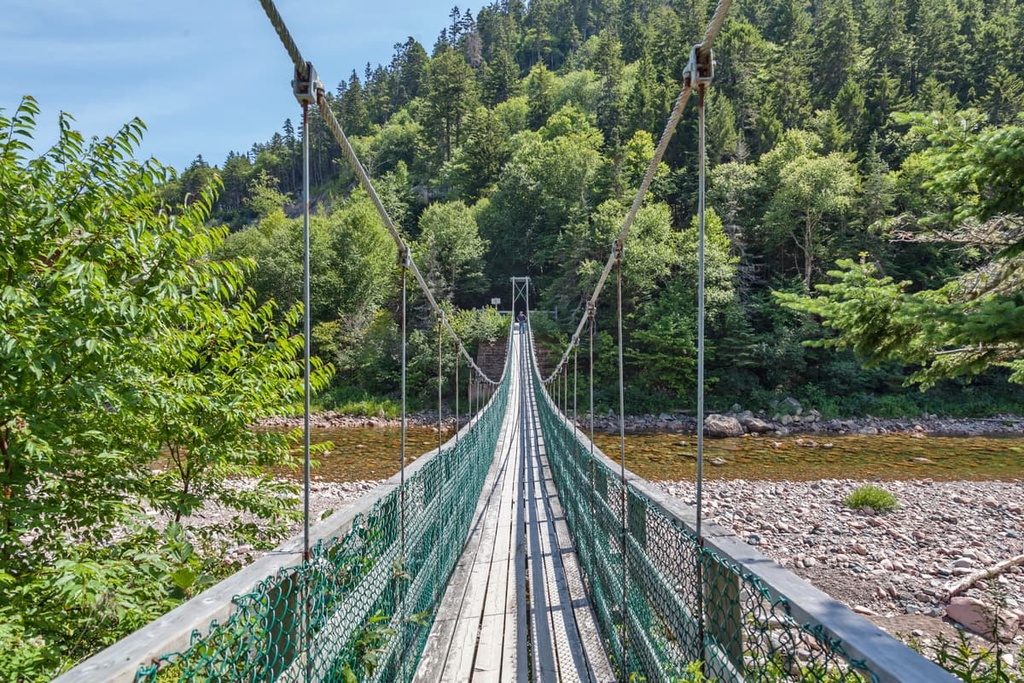
Explore Fundy National Park of Canada with the PeakVisor 3D Map and identify its summits.








